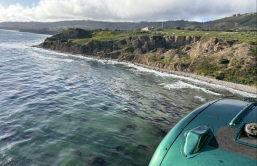Earthquakes are known for the chaos that comes with their strength, but researches are concerned about another dangerous aspect that comes with the quakes: the release of methane gas from the seabed.
In a study published online Sunday in the journal Nature Geoscience, researchers reported an underwater quake off of Pakistan close to 70 years ago fractured seafloor sediments and created pathways for methane.
Researchers found a release of methane, a greenhouse gas, from below, and suggest enough of the gas has been released to take into account how much is escaping into the air.
David Fischer, a postdoctoral researcher at the University of Bremen in Germany and the lead author of the study, offered an explanation of his research in a news release:
"First, we examined the pore water, which is the water between sediment grains in the core", explains first author Dr. David Fischer from MARUM. "At two separate coring sites, one with hydrates the other without, we found unusual pore water sulfate profiles indicating a substantial increase in upward methane flux in the recent past."
The presence of methane at shallower sediment depths was further corroborated by enrichments of the mineral barite at these depths. These barite enrichments were calculated to have started to form between 1916 and 1962. "Both the sulfate and the barite analyses indicated that in the recent past, something must have amplified the methane flux from below. We started going through the literature and found that a major earthquake had occurred close-by in 1945," explains Fischer. "Based on several indicators, we postulated that the earthquake led to a fracturing of the sediments, releasing the gas that had been trapped below the hydrates into the ocean."
Fischer added the quake itself was recorded to be magnitude 8.1, and a resulted in a tsunami, killing more than 4,000 people. There were gas -hydrate sediments that were released and did not dissolve.
"The quake broke open gas-hydrate sediments and the free gas underneath migrated to the surface," Fischer said. "They remain there."








